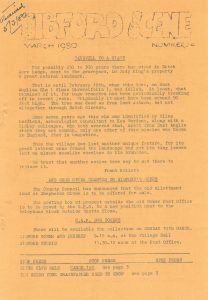While we enjoy the peace and harmony of Sibford it is almost impossible to conceive that a part of our own country is in a state of war.
We print this month part of a letter from Charles Stephens, who is serving with the 1st Battalion Welsh Guards in South Armagh, to his aunt in Sibford.
“Yes, Northern Ireland is very much a soldiers’ war; it is the N.C.O. or corporal who has immense responsibility, not only for the lives of the men he commands; but also to be aware of the political implications of his actions. It is quite remarkable how, by and large, they react to responsibility and grow into it. I believe we are lucky — we have always allowed N.C.O.s to do their job, and our strength, more than any other part of the army, is in our Sergeants’ Mess. We also have lots of officers, and mostly good ones, and are therefore in a much better position to conduct offensive and well planned operations than most other regiments.
It is a fascinating scene, and very much proper soldiering. We have had some successes recently, which is always encouraging, but we are really doing little more than scratching the surface. However, there are signs that there is some political resolution. Morale everywhere is very high; it has never really been low, but January has been a long month and certainly a testing one for the leaders. It is always interesting seeing how people develop and react in stress situations, and how often the stars fail to shine and the so-called duds prove their worth.
We are having a major blitz against smuggling at the moment, which is certainly linked to terrorism. You would be amazed by the situation here, the lawlessness which has existed for years and the goings on which people have to endure.
We have been lucky with the weather so far this winter, clear and cold. We hate fog and mist which stops as helicoptering, and the opposition know it; but we have to keep patrols out to stop them mortaring us. We helicopter or walk everywhere and never drive, except this last week when we have had to run engineer stores to Forkhill and Crossmaglen. It is a major operation; every inch of the road has to be searched and cleared. The pickets are then flown in to guard the road and dig-in in the fields and on the hills watching the road for three days while our convoys run up and down. It’s like Aden was but worse! Think of it in England.”
